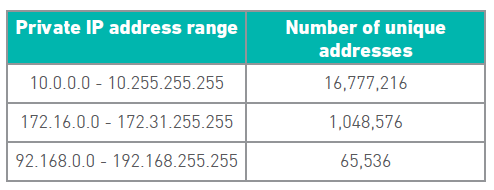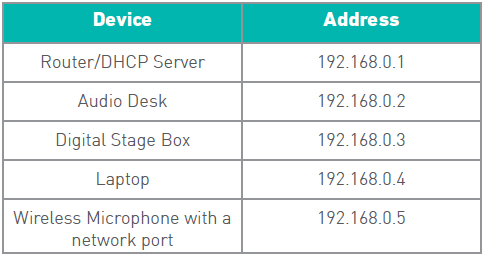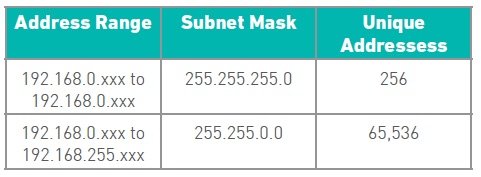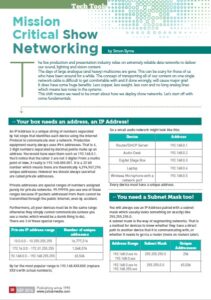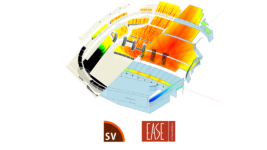News
28 Mar 2019
Mission Critical Show Networking

Subscribe to CX E-News
TECH TOOLS
Mission Critical Show Networking
by Simon Byrne.
The live production and presentation industry relies on extremely reliable data networks to deliver our sound, lighting and vision content. The days of large analogue (and heavy) multicores are gone. This can be scary for those of us who have been around for a while. The concept of transporting all of our content on one single network cable is difficult to get comfortable with and if done wrongly, will cause major grief. It does have some huge benefits. Less copper, less weight, less cost and no long analog lines which means less noise in the systems. This shift means we need to be smart about how we deploy show networks. Let’s start off with some fundamentals.
Your box needs an address, an IP Address!
An IP Address is a unique string of numbers separated by full stops that identifies each device using the Internet Protocol to communicate over a network. Production equipment nearly always uses IPv4 addresses. That is 4, 3 digit numbers separated by decimal points make up an address.
You would have seen them such as 192.168.0.1. You’ll notice that the latter 2 are not 3 digits! From a maths point of view, it really is 192.168.000.001. It is a 32 bit number which means there are theoretically 4,294,967,296 unique addresses. However we should always use what are called private addresses.
Private addresses are special ranges of numbers assigned purely for private networks. 99.9999% you use one of these ranges because IP packets addressed from them cannot be transmitted through the public Internet, even by accident. Furthermore, all your devices must be in the same range otherwise they simply cannot communicate (unless you use a router, which would be a dumb thing to do).
There are 3 of these special ranges.
By far the most popular range is 192.168.XXX.XXX (replace XXX’s with actual numbers). So a small audio network might look like this:
Every device must have a unique address.
You need a Subnet Mask too!
You will always see an IP Address paired with a subnet mask which usually looks something (or exactly) like 255.255.255.0.
A subnet mask is the way of segmenting networks. That is a method for devices to know whether they have a direct path to another device that it is communicating with, or whether it needs to go via a router (more on routers later).
Put it this way, if you have less than 255 devices on your network, your subnet would be 255.255.255.0. If you have more than 255 devices, you are in the realm of serious networking and you probably want a professional to help you with a networking strategy.
How do these devices get these addresses anyway?
There are 2 ways, Static and Dynamic addressing, or a combination of both.
Static addressing is where someone literally enters a unique IP address and subnet mask number manually into a device. That person needs to ensure that they keep track of everything so that they do not create any problems or conflicts.
The benefit is that you know precisely what address is being used for each statically assigned device. The downside is that it takes time to set and if you have a lot of devices, you might not have that time available. Despite this, some equipment only has static addressing.
Dynamic addressing is where addresses are dynamically assigned by a “DHCP Server”. A DHCP server is a feature of nearly all routers. This is a huge time saver and is the standard way that most networks operate. This is what I do, I give static IP’s to the big stuff such as the router, switches, mixing desk and digital stage boxes. Everything else is dynamically assigned.
And talking of Routers…
It is good to have one. Firstly, they contain a DHCP server which provides IP addresses for your other devices. They usually have a network switch with 4 or so ports which is useful at FOH, and with a Wifi version, you can connect your phone/ipad which gives you remote control of other devices such as the mixing desk, wireless mikes etc.
If you don’t have a router with DHCP, you must manually assign all IP addresses to all of your devices… somewhat boring.
They can also connect your network to the internet (which is actually their primary function). However, you want an extremely good reason to risk connecting your private, mission critical show network to the internet and it is definitely not recommended.
I have a couple of Apple Airport Extreme routers for my shows. They are set up like this:
Ip Address is 192.168.0.1
Subnet Mask 255.255.255.0 (which means my network can only have up to 255 devices).
The DHCP server within the router is setup to only provide addresses from 192.168.0.129 to 192.168.0.254. That leaves 192.168.0.2 to 192.168.0.128 to be available for static assigning to other devices.
Special Note – There is a protocol designed to interconnect devices without a DHCP server or static assigning called “link local”, self assigned IP addresses. Most computers can do this. However, they are not guaranteed as unique so this method is unpredictable and is not recommended in a show critical network.
To be fair, companies such as Dante, Yamaha, Soundcraft and Allen & Heath have done a fantastic job of making this technology work with their equipment. The problems arise when other items are added to these ecosystems.
Put it this way, it is an inconvenience if the office printer does not print because of a network addressing problem, it is a catastrophe if the PA system fails during a show due to poor IP addressing.
Self assigned IP addresses are easy to spot as they always start with 169.254.XXX.XXX. This is a great hint if you are trying to diagnose network problems. Always have a dedicated private network with a good numbering scheme. A small audio network might look something like this:
In this small example, all items start with 192.168.0.X which means they are in the same private network, followed by a unique number. Some of the unique numbers have been manually assigned, the other were dynamically assigned by the DHCP in the Airport extreme.
You will notice that there is no device with the address 192.168.0.0. This is a special address used for designating a whole network when creating a path between separate networks. It must not be used for most of our applications.
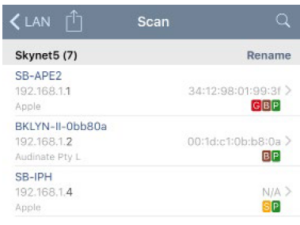 Network Scanners
Network Scanners
Network Scanners are cheap (or free) apps that scan your network for connected devices and returns their IP addresses. They are invaluable for quickly identifying network problems. They are available for all platforms. I like:
» For iPhone or Android – Network Analyzer
» For Windows, Mac and Linux – Angry IP Scanner.
Network Switches
Switches are the heart of any network. They take data traffic and efficiently route to where it needs to go, and importantly does not route it to where it does not need to go. This keeps
the traffic on the total network to manageable levels. It makes sense to invest in them wisely.
All switches at a minimum should have this:
» Spend some decent money – You have spent some serious coin on the rest of your equipment, so don’t skimp on the boxes that bring it all together.
» At least 1gigabit speed – 10/100 megabit has no place in our realtime networks. They simply don’t have the throughput needed.
» Good indicator lights – Really useful for quickly establishing whether things are connected and traffic is passing.
» Avoid Wall Worts – My pet hate. Buy a quality router that has a built in power supply with a good AC connection that can be secured. You don’t want a show to fail because that twenty buck wall wort fell out!
Here are some features you also probably want:
» Qos (Quality of Service) – Qos is a data packet prioritising system. High priority traffic is tagged by the sender as such (say, realtime audio), and the lower priority stuff has to wait (say the the iPad remote control of your desk).
» Rapid Spanning Tree Protocol – Networks cannot have loops (the digital equivalent of feedback), yet it is desirable to have some redundancy between front of house and the stage. Rapid Spanning Tree Protocol (RSTP) will let you connect 2 cables between 2 switches. If one of the cables fails, the switches will switch to the 2nd cable. It is not seamless, but it is better than nothing.
» Loop Protection – Poorer version of Rapid Spanning Tree Protocol. Loop protection does the same job but does it by blocking one of the duplicated ports to stop a loop. If the first connection fails, the switches unblock the 2nd ports.
» Power over Ethernet (POE) – Power over Ethernet provides a DC power supply over the ethernet cable. I suspect this will become more important as more professional products are powered by POE.
» Ethercon – Ethercon is the ruggedised and lockable version of the 8P8C connector (often known as RJ45) manufactured by Neutrik. If budget can extend to a switch with Ethercon, it is well worth the extra investment.
From CX Magazine 118 – September 2016
CX Magazine is Australia and New Zealand’s only publication dedicated to entertainment technology news and issues – available in print and online. Read all editions for free or search our archive www.cxnetwork.com.au
© CX Media
Subscribe
Published monthly since 1991, our famous AV industry magazine is free for download or pay for print. Subscribers also receive CX News, our free weekly email with the latest industry news and jobs.

